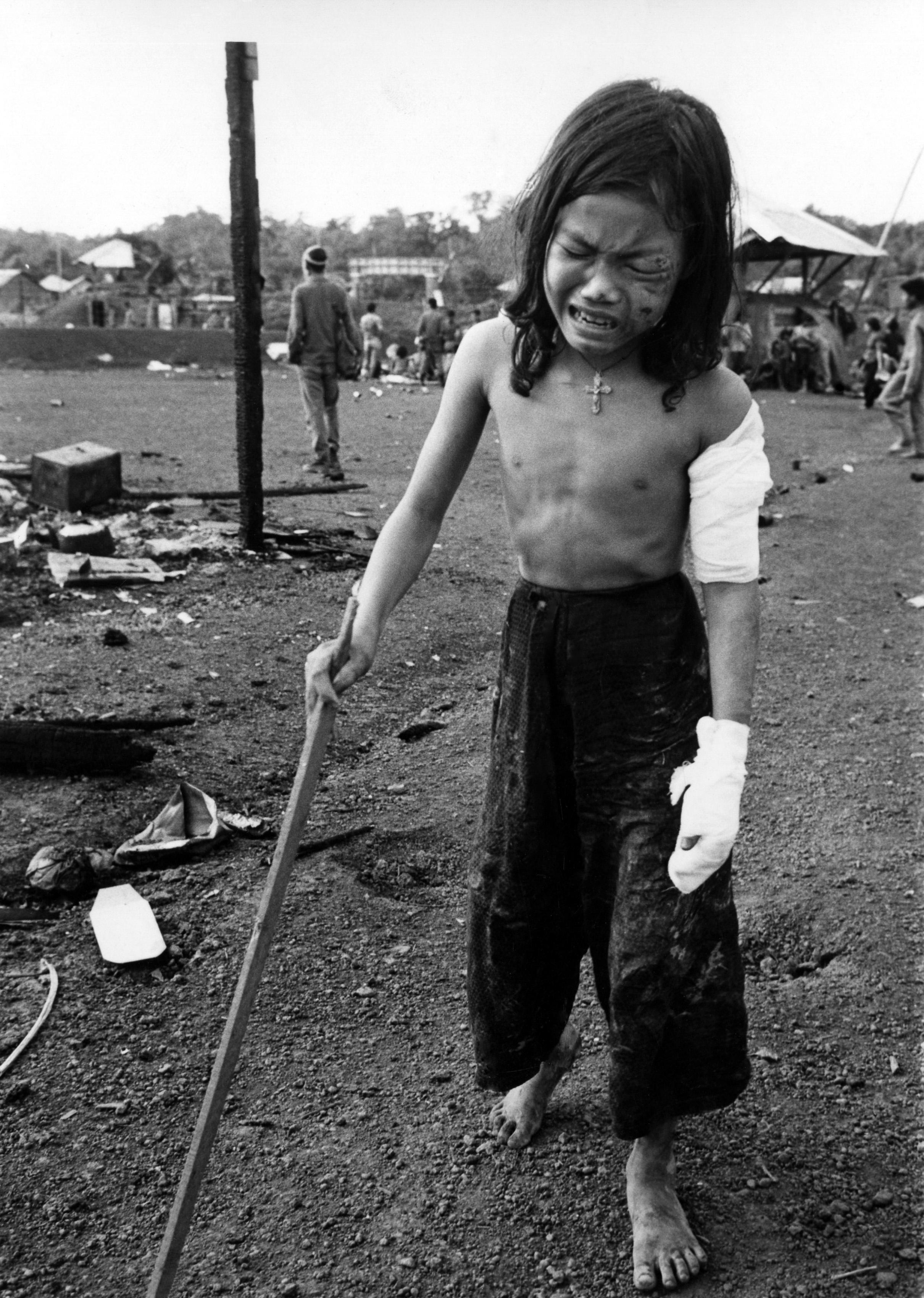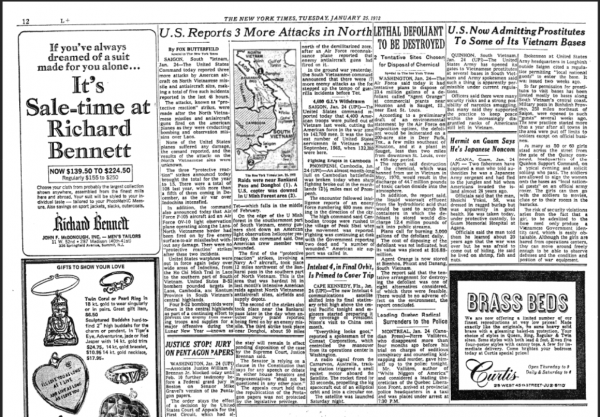Bob Avakian has written that one of three things that has “to happen in order for there to be real and lasting change for the better: People have to fully confront the actual history of this country and its role in the world up to today, and the terrible consequences of this.” (See “3 Things that have to happen in order for there to be real and lasting change for the better.”)
In that light, and in that spirit, “American Crime” is a regular feature of revcom.us. Each installment focuses on one of the 100 worst crimes committed by the U.S. rulers—out of countless bloody crimes they have carried out against people around the world, from the founding of the U.S. to the present day.
See all the articles in this series.

This little girl was injured and orphaned in a bloody attack by U.S. and puppet South Vietnamese troops against the Vietnamese National Liberation Front (the so-called “Vietcong”) forces at Dong Xoai, South Vietnam, June 10, 1965. Photo: AP
THE CRIME
America’s genocidal war in Vietnam during the 1960s and 1970s resulted in at least two to three million Vietnamese deaths and possibly as many as four million. As one little known but horrific part of this towering crime against humanity, the U.S. military participated in the creation of a huge “brothel economy” in Vietnam, Thailand and the Philippines. Rather than liberating the Vietnamese, they were subjugating an estimated half a million women to sexual domination by the U.S.
There were approximately more than 7.5 million tons of bombs dropped by the U.S. military on Vietnam, Laos and Cambodia between 1965 and 1975 as well as at least 20 million gallons of deadly herbicides sprayed throughout the lands. Encyclopedia.com reports, “The widespread destruction of the farms and villages in the South Vietnamese countryside turned huge numbers of peasants into homeless refugees. Many of these people fled to the cities where they made a living in any way they could—including through illegal activities. The poverty and desperation of the war years—along with the influence of Americans—resulted in major changes to Vietnamese families, culture, and society.” Even a mainstream American journalist, who thought the U.S. was “motivated by the loftiest intentions,” admitted in his book Vietnam: A History that the U.S. war against Vietnam “did indeed rip South Vietnam’s social fabric to shreds.”

A woman tries to carry a child to safety as U.S. Marines storm the South Vietnamese village of My Son searching for National Liberation Front (“Vietcong”) fighters, April 1965. Photo: AP
The city of Saigon was known as a brothel to many U.S. soldiers. Once a month, military personnel would get a couple days to themselves for a little R&R, rest and recuperation, or in the words of some soldiers, “intoxication and intercourse.” “In fact, I don’t know anyone in my unit who expressed the slightest bit of interest in Vietnam’s culture or history. When we went on five days of R&R during our tour of combat—for example to Hong Kong, Thailand, Okinawa, Japan or the Philippines—most of us were interested in only one thing: getting drunk and getting laid,” Lloyd Lofthouse, a U.S. Marine and Vietnam veteran, recalls about his time in the Vietnam.
With a neocolonial and racist way of thinking, that Asian women were “exotic” and naturally “submissive” to Western superiority, the GIs kept the bar girls, masseurs and sex slaves of East Asia employed. According to Nanette J. Davis in Prostitution: An International Handbook on Trends, Problems and Policies, over the course of the 10-year war, there were an estimated 500,000 Vietnamese prostitutes servicing U.S. troops, translating to approximately one prostitute per American soldier at the height of the U.S. savage war and occupation. In a New York Times op-ed, “How Not to Win ‘Hearts and Minds,’’’ George C. Herring, professor emeritus of history and author of America’s Longest War: The United States and Vietnam, 1950-1975, cited how the “number of houses of ill-repute expanded proportionately as the number of Americans in Saigon surged into the tens of thousands.” Herring notes how this provoked criticism from U.S. Senator J. William Fulbright, who asserted that “both literally and figuratively Saigon has become an American brothel” while criticizing American foreign policy, which he followed with cited reports of “Vietnamese putting wives or daughters to work as bar girls” or “to peddle them to American soldiers as mistresses.”
Cases in which a woman’s or a girl’s entire family were somehow involved in the sale of her body were not uncommon. Women and children were lured into prostitution as a means of survival. Many, perhaps even a majority, of the prostitutes employed by U.S. military personnel during the Vietnam War or later in Southeast Asia were minors. Bar girls would find themselves indebted to the oftentimes violent bar owners, thus always keeping them enslaved. As noted by Madi Gilkes in Trouble & Strife, others would be recruited by Americans to serve U.S. Army camps. Every day, women would be transported to military bases to earn their monthly incomes based on how many soldiers they had sex with and the amount of hours they put in.
Taina Bien-Aime, Executive Director of Equality Now, said that Thailand becoming a sex tourism destination was condoned and sanctioned by Robert McNamara. McNamara, U.S. Defense Secretary for President Lyndon B. Johnson, oversaw massive troop and bombing escalations during the war in Vietnam. In 1967, the Thai government and Defense Secretary McNamara completed a pact in which Thailand agreed to provide R&R leave for American soldiers and in return would secure economic developmental perks. The U.S. government, entrenched in the Vietnam War, signed this treaty with Thailand enabling U.S. soldiers to come ashore for R&R and giving the sex tourism industry what amounted to official sanction, and a new era dawned. Less than a decade later, Thailand could claim more than 20,000 brothels and other sex-industry establishments; and the hyped mythology of the young, submissive, sexy girls waiting for wealthy tourists in sultry Southeast Asia was making its way around the world.
Richard Marcinko, a retired U.S. Navy Seal commander and Vietnam War veteran, recounts in his autobiography Rogue Warrior, “My social life was as busy as my professional schedule. Women were plentiful. There were the local LBFMs—Little Brown Fucking Machines—brought in an endless supply by my houseboy Sothan.” LBFM was a term American troops used to describe Vietnamese women during the war, and it was later used to describe Filipino and indigenous women. The women, called “dollar-earning patriots” by some, and the children born from prostitution were oftentimes ostracized by their families and communities so badly that the girls fathered and left behind by U.S. servicemen often went into sex work as the only choice open to them.
A major source of Thailand’s economic growth during America’s imperialist war was the commodification of women’s bodies. Not only did it dehumanize and brutalize the women, but it helped shape Thailand’s development as a destination and mecca for sex tourism. When American bases started closing in the Philippines and Thailand, those countries refocused their attention on attracting foreign tourists. Frances L. Starner, in his 1967 article “Thai Sins,” published in the Far Eastern Economic Review, reported that an estimated 250,000 foreign tourists visited Thailand in 1965. Tourism was the sixth greatest source of foreign currency in Thailand in 1967—and by the mid-1990s, it would be the greatest.1
In his book Disposable People, Kevin Bales wrote of Thailand’s brothels that by 1996, the country had more than seven million tourist visits a year, 66 percent of which were unaccompanied men. More recently, National Public Radio reported that the total worth of the sex industry in Thailand is approximately $6.4 billion, which equals three percent of the total national budget. The National Center for Biological Information at Thailand’s Mahidol University estimates that approximately 36,000 out of 150,000-200,000 prostitutes in the country are children.
THE CRIMINALS
The U.S. imperialist government and military, from its commanding levels on down, all played a part. From their establishing actual brothels on military bases to soldiers being encouraged by officers to use them and being given condoms, the legal and illegal sex trade thrived because of this in Southeast Asia.
The pro-U.S. puppet governments of South Vietnam, Thailand and the Philippines were also responsible for such atrocities committed against women.
THE ALIBI
The age-old alibi of “men will be men” is heard from various directions, as well as “there were laws against prostitution, so what happened was not our doing or it couldn’t have been stopped.” Some would say that the women and families were “voluntarily” doing this; others would claim they were “helping these poor girls out with a few dollars.”
On January 25, 1972, the New York Times ran an article with the headline “U.S. Now Admitting Prostitutes To Some of Its Vietnam Bases,” which stated that even though there were concerns about narcotics being smuggled into the bases, “many said they supported the practice to keep peace within the increasingly disgruntled ranks of Americans still left in Vietnam.”
This dangerous way of thinking continued well into the years that followed the war. One of the biggest cases in relation to this was when, in 1995, three U.S. servicemen pled guilty to having rented a van and abducting a 12-year-old girl in Okinawa, Japan, and then raping her. U.S. Navy Admiral Richard C. Macke, when asked about the incident, replied, “I think it was absolutely stupid, I’ve said several times. For the price they paid to rent the car, they could have had the girl.”
THE REAL MOTIVE
The establishment of military brothels, sex education and hiring of prostitutes for U.S. military personnel were all ways for the U.S. military and government to “keep morale high” in order to continue carrying out the U.S. atrocities against the Vietnamese people. A 1966 Time magazine article, “Disneyland East,” explained that the An Khe brothel, a 25-acre complex nicknamed “Disneyland” by soldiers, was owned by Vietnamese, but U.S. military police “patrol[ed] the compound and check[ed] the pass of each GI entering.”
Mass murder in the jungle by day, sexual Disneyland by night. The open secret that women and their bodies were seen as the “spoils” of war boosted recruitment for the U.S. military. Think about what this tells you about the oppressive social relations that this army embodies and enforces.
Some of the information for this article was drawn from “The U.S. Military and the Growth of Prostitution in Southeast Asia,” by Preston Jones, Advisory Board Member, ECPAT-USA, an anti-human trafficking policy organization.
1. The U.S. military-related prostitution-trafficking also spread to the Philippines, where there was a large American military presence, and this went on through the 1990s, especially around large U.S. air and naval bases like Clark and Subic Bay. [back]


